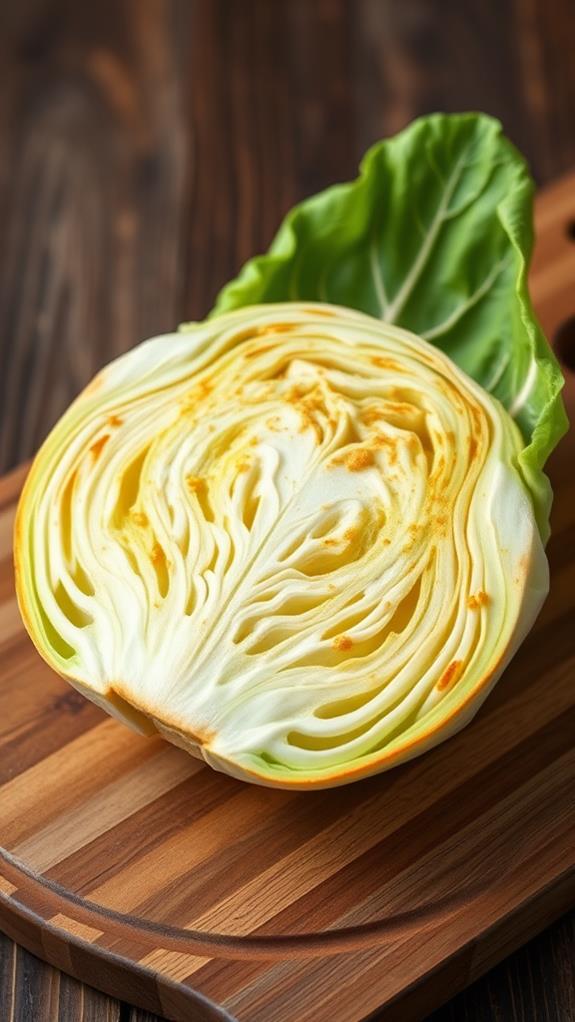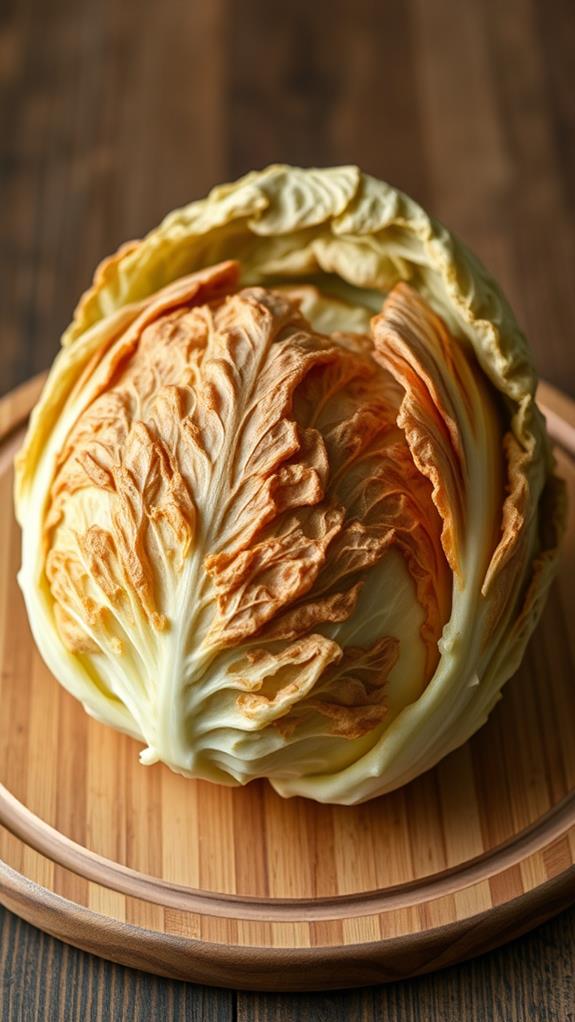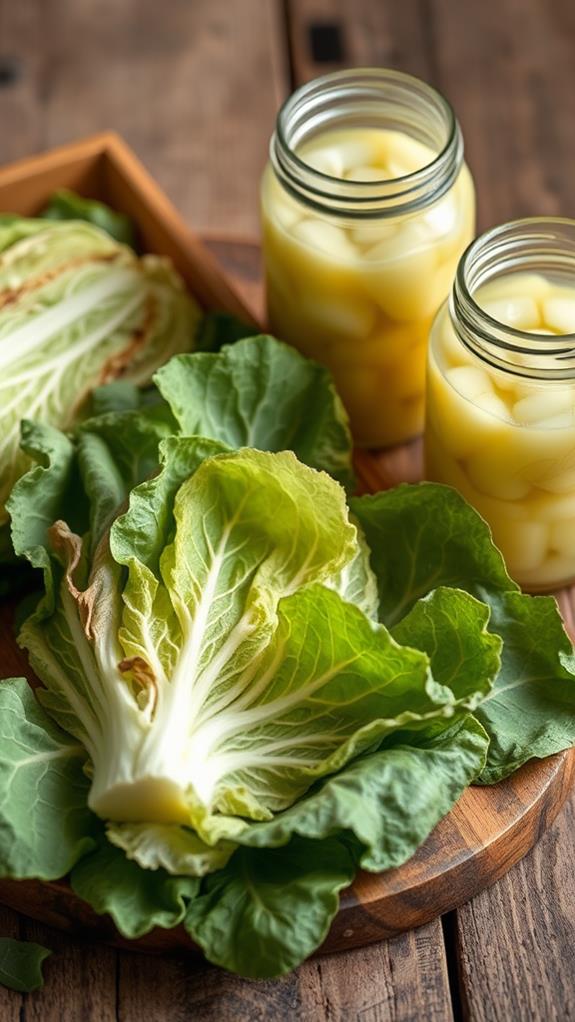Is Brown Cabbage Safe to Eat
Brown cabbage is generally safe to eat, but you'll need to assess its condition carefully. Discoloration can occur due to oxidation, age, storage conditions, physical damage, or fungal infections. If the brown spots are small and localized, you can safely consume the cabbage within 3-5 days if refrigerated. However, avoid eating cabbage with extensive dark spots, slimy texture, or strong off-odors, as these indicate spoilage. Fresh cabbage should have crisp, vibrant leaves, uniform coloration, and a solid, heavy feel. When in doubt, trust your senses: visual inspection, texture check, and smell test can help you determine if your cabbage is still good. Understanding the causes and signs of cabbage discoloration can help you make informed decisions about its edibility.
This post may contain affiliate links. If you make a purchase through these links, I may earn a commission at no additional cost to you. Additionally, portions of this post may be generated using artificial intelligence (AI) technology. While we strive for accuracy, please be aware that AI-generated content may not always be perfect and should be fact-checked when necessary.
The Spatula Scoops
- Brown cabbage is generally safe to eat if discoloration is limited and no other signs of spoilage are present.
- Consume brown cabbage within 3-5 days of noticeable discoloration if stored properly in the refrigerator.
- Avoid eating cabbage with extensive dark spots, slimy texture, or strong off-odors, as these indicate spoilage.
- Slight browning due to oxidation or minor physical damage doesn't necessarily mean the cabbage is unsafe to eat.
- Always inspect cabbage thoroughly, checking for freshness indicators like crisp leaves and a mild, sweet aroma before consumption.
Understanding Cabbage Discoloration

Discoloration in cabbage can be a source of confusion for many home cooks. You might notice your cabbage turning brown and wonder if it's still safe to eat. This change in color is often due to oxidation, a natural process that occurs when the vegetable's cut surfaces are exposed to air. It's similar to how an apple turns brown after you slice it. Much like green garlic, the color change in cabbage doesn't necessarily indicate spoilage or a loss of nutritional value.
Several factors can contribute to cabbage discoloration. Age is a significant one; as cabbage gets older, it's more likely to develop brown spots. Storage conditions also play a role. If you've kept your cabbage in a humid environment or at temperatures that are too high, you may see more browning. Physical damage, like bruising during transport or handling, can trigger oxidation too.
It's important to distinguish between normal discoloration and signs of spoilage. While some browning is often harmless, extensive dark spots, a slimy texture, or an off-odor indicate that the cabbage has gone bad. In those cases, it's best to discard the vegetable to avoid potential foodborne illness.
Causes of Brown Spots
The development of brown spots on cabbage can be attributed to several factors. One common cause is physical damage during harvesting, transportation, or storage. When the cabbage's outer leaves are bruised or cut, it can lead to oxidation and discoloration. Another culprit is ethylene exposure, a naturally occurring plant hormone that accelerates ripening. If you've stored your cabbage near ethylene-producing fruits like apples or bananas, you might notice brown spots developing more quickly. Similar to cabbage, refrigerator odors can also be caused by spoiled produce, emphasizing the significance of proper food storage and regular fridge maintenance.
Fungal infections, such as those caused by Alternaria or Botrytis, can also result in brown spotting. These pathogens thrive in warm, humid conditions and can spread rapidly if left unchecked. Additionally, nutrient deficiencies during the growing process may manifest as brown spots on mature cabbage heads. For instance, a lack of calcium can cause tipburn, which appears as brown edges on inner leaves. Ultimately, prolonged exposure to extreme temperatures, either too hot or too cold, can stress the cabbage and lead to discoloration. It is crucial to recognize that while these brown spots may affect the cabbage's appearance, they don't always indicate that the entire vegetable is unsafe to consume.
Assessing Cabbage Quality

When you're evaluating cabbage quality, you'll want to rely on multiple senses. Start with a visual inspection, looking for any discoloration or signs of decay beyond normal browning. Much like examining a John Boos cutting board for quality, you should use your hands to assess the cabbage's condition. Next, gently squeeze the cabbage to check its texture and firmness, as a fresh cabbage should feel solid and heavy for its size. Don't forget to use your nose, as the smell test is pivotal; a fresh cabbage should have a mild, pleasant aroma without any strong or off-putting odors.
Visual Inspection Techniques
Examining your cabbage closely can reveal important clues about its freshness and safety. When inspecting a cabbage, pay attention to its overall appearance, color, and texture. Start by checking the outer leaves for any signs of discoloration, wilting, or damage. Fresh cabbage should have crisp, vibrant leaves without any soft spots or blemishes.
Next, focus on the cabbage's color. While slight browning on the cut edges is normal, extensive brown patches or discoloration throughout the leaves may indicate spoilage. Look for:
- Uniform coloration across the leaves
- Absence of dark spots or patches
- No signs of mold or fuzzy growth
If you notice any of these issues, it's best to err on the side of caution and discard the cabbage. Additionally, gently squeeze the cabbage to evaluate its firmness. A fresh cabbage should feel solid and heavy for its size. If it's soft or spongy, it may be past its prime. Remember, visual inspection is just one component of evaluating cabbage quality. Combine these techniques with other methods, such as smell and texture evaluation, to make an informed decision about your cabbage's safety and freshness.
Texture and Firmness
Evaluating a cabbage's texture and firmness is essential for determining its quality and safety. When you're inspecting a cabbage, gently squeeze it in your hand. A fresh, healthy cabbage should feel firm and dense, with tightly packed leaves. If it's soft or spongy, that's a sign of deterioration.
Run your fingers over the surface of the cabbage. The outer leaves should feel crisp and slightly waxy. If they're limp, wilted, or excessively dry, it's an indication that the cabbage is past its prime. Pay attention to any mushy spots, which could signal decay.
Next, give the cabbage a gentle shake. You shouldn't hear any rattling or sloshing sounds from within. These noises might indicate that the inner leaves have started to rot or separate.
Smell Test Importance
The smell test is perhaps the most vital step in evaluating a cabbage's quality and safety. When you're assessing a cabbage, your nose can be your best tool. A fresh, healthy cabbage should have a mild, slightly sweet aroma. If you detect any off-putting odors, it's a clear sign that the cabbage may have gone bad.
The key things to look out for when performing a smell test are:
- Pungent, sour odors that indicate fermentation has begun
- Musty, moldy smells suggesting fungal growth
- Sulfurous or rotten egg-like scents, which signal decomposition
These unpleasant aromas are often accompanied by visible signs of spoilage, such as discoloration or soft spots. It's critical to trust your senses when evaluating produce. If something smells off, it's best to err on the side of caution and discard the cabbage. Remember, your olfactory senses have evolved to help you detect potentially harmful substances, so don't ignore them when it comes to food safety. By incorporating the smell test into your routine, you're employing a powerful, natural tool to confirm the quality and safety of your vegetables.
When to Eat Brown Cabbage
When it comes to brown cabbage, you'll want to be aware of the safe consumption timeframe and signs of spoilage. Generally, slightly browned cabbage can be eaten if it's only been stored for a few days and doesn't show other signs of decay. Proper storage in a breathable bag or container within the refrigerator can help maintain freshness and quality for up to a week. However, you should avoid eating cabbage that's excessively brown, slimy, or emits a strong, unpleasant odor, as these are clear indicators that the vegetable has spoiled and is no longer safe for consumption.
Safe Consumption Timeframe
To guarantee you're consuming brown cabbage safely, it's essential to understand its shelf life and ideal consumption timeframe. Brown cabbage, which is typically regular cabbage that's started to discolor, can still be safe to eat if handled properly. Generally, you should consume brown cabbage within 3-5 days of noticing the discoloration, provided it's been stored in the refrigerator.
When deciding whether to eat brown cabbage, consider these factors:
- Smell: If there's a strong, unpleasant odor, it's best to discard it.
- Texture: Avoid cabbage that's become slimy or excessively soft.
- Mold: Any visible mold growth indicates it's no longer safe to consume.
It's pivotal to inspect the cabbage thoroughly before consumption. If you've cut the cabbage and only a small portion has browned, you can trim away the discolored parts and use the rest within 24 hours. Remember, proper storage is key to maximizing shelf life. Keep your cabbage in a perforated plastic bag in the crisper drawer of your refrigerator. This method helps maintain ideal humidity levels, slowing down the browning process and extending the safe consumption window.
Signs of Spoilage
Vigilance is key when determining whether brown cabbage is still safe to eat. You'll want to look for several telltale signs of spoilage. First, check the texture. If the cabbage leaves feel slimy or mushy, it's time to discard them. Fresh cabbage should be crisp and firm to the touch.
Next, examine the color. While some browning is normal, extensive discoloration or black spots indicate decay. Pay attention to any unusual odors, too. Fresh cabbage has a mild, slightly sweet smell. If you detect a strong, unpleasant odor or a sour smell, it's best to err on the side of caution and throw it out.
Look for signs of mold growth, which can appear as fuzzy patches in various colors. Even if the mold is only on one part, it's safest to discard the entire cabbage head. Wilting leaves are another indicator of age, though not necessarily spoilage. If the outer leaves are wilted but the inner core remains firm, you can often salvage the cabbage by removing the outer layers.
Signs of Spoiled Cabbage

Recognizing spoiled cabbage is crucial for food safety. You'll want to use your senses to identify any signs of deterioration. Look for discoloration, particularly brown or black spots, which indicate decay. If you notice a slimy texture or wilted leaves, it's time to discard the cabbage. Trust your nose too; a strong, unpleasant odor is a clear sign of spoilage.
When inspecting your cabbage, be on the lookout for these telltale signs:
- Visible mold growth, which can appear as fuzzy patches in various colors
- Soft or mushy areas that feel different from the rest of the cabbage
- Yellowing or browning of the leaves, especially if accompanied by an off-putting smell
Proper Cabbage Storage Techniques
Proper storage is key to maintaining cabbage's freshness and preventing spoilage. To keep your cabbage at its best, you'll want to follow these storage techniques. First, don't wash the cabbage before storing it; excess moisture can lead to faster decay. Instead, remove any loose or damaged outer leaves, and store the head whole.
For short-term storage, place the cabbage in a plastic bag with a few small holes for airflow. Keep it in your refrigerator's crisper drawer, where it can last up to two weeks. If you're planning for long-term storage, consider wrapping the cabbage tightly in plastic wrap and placing it in the freezer. This method can preserve it for up to 18 months.
If you've already cut your cabbage, wrap the unused portion tightly in plastic wrap or store it in an airtight container. Use it within a few days for ideal freshness. For shredded cabbage, store it in a sealed plastic bag with a paper towel to absorb excess moisture. Remember, proper storage not only extends shelf life but also helps maintain the cabbage's nutritional value and flavor profile.
Extending Cabbage Shelf Life

Three key strategies can help you extend your cabbage's shelf life appreciably. First, keep your cabbage whole and unwrashed until you're ready to use it. This preserves its natural protective layers. Second, store it in a cool, dark place with good air circulation. A refrigerator's crisper drawer is ideal, set to high humidity. In conclusion, wrap the cabbage loosely in a plastic bag with small perforations to allow for some airflow while retaining moisture.
To further maximize your cabbage's longevity, consider these additional tips:
- Inspect regularly for any signs of spoilage
- Remove outer leaves as needed to maintain freshness
- Avoid storing near ethylene-producing fruits like apples or pears
Cooking With Discolored Cabbage
While proper storage can extend your cabbage's life, you might still encounter discoloration. Don't be too quick to toss that brown cabbage, though. In many cases, you can still use it in your cooking.
First, inspect the cabbage carefully. If it's just a few brown spots on the outer leaves, you can simply remove those leaves and use the rest. The discoloration often doesn't affect the taste or safety of the inner leaves. However, if you notice any signs of mold or a strong, unpleasant odor, it's best to discard the entire head.
When cooking with slightly discolored cabbage, consider recipes that involve chopping or shredding. This way, any remaining brown bits will be less noticeable. Stir-fries, slaws, and soups are excellent options. The cooking process can also help mask any minor color changes. Remember to adjust your cooking time if the cabbage is softer than usual, as overcooked cabbage can become mushy and lose its nutritional value. By being resourceful and mindful, you can still create delicious dishes with slightly discolored cabbage, reducing food waste in the process.
Frequently Asked Questions
Can Brown Cabbage Cause Food Poisoning?
Brown cabbage can potentially cause food poisoning if it's spoiled or contaminated. You should be cautious when consuming cabbage that's turned brown, as it may indicate decay or bacterial growth. While not all brown spots are harmful, they can be a sign of rotting. If you notice an off smell, slimy texture, or mold, it's best to discard the cabbage. To minimize risk, always wash your cabbage thoroughly and cook it properly before eating.
Are There Any Nutritional Differences Between Brown and Green Cabbage?
Time to leaf through the nutritional differences between brown and green cabbage! You'll find that both varieties offer similar nutritional profiles. However, brown cabbage might have slightly higher levels of certain antioxidants, like polyphenols. Green cabbage typically contains more vitamin C. The differences aren't significant enough to drastically impact your health. Both types are low in calories and rich in fiber, vitamins, and minerals. Ultimately, either choice will provide valuable nutrients to your diet. Choose based on taste preference and availability.
How Does Brown Cabbage Taste Compared to Fresh Green Cabbage?
You'll notice a distinct difference in taste between brown and fresh green cabbage. Brown cabbage typically has a stronger, more bitter flavor compared to its fresh counterpart. It's often described as earthy or nutty, with a more intense cabbage taste. The texture might also be less crisp and more wilted. While some people enjoy this robust flavor, others find it less appealing. If you're used to fresh green cabbage, you might find brown cabbage's taste to be an acquired one.
Can You Freeze Brown Cabbage for Later Use?
Don't put all your cabbage in one basket when it comes to freezing brown cabbage. You can freeze it, but it's not ideal. The texture will become mushy when thawed, making it less appealing for raw dishes. However, it's still usable for cooked recipes. To freeze, remove any spoiled parts, chop the cabbage, blanch it briefly, then cool and pack in airtight containers or freezer bags. It'll keep for about 6-8 months in the freezer.
Are There Any Specific Recipes That Work Well With Brown Cabbage?
You'll find several recipes that work well with brown cabbage. Try sautéing it with garlic and olive oil for a simple side dish. It's great in stir-fries, adding a nutty flavor to the mix. You can also use it in soups, stews, or casseroles, where it'll contribute a hearty texture. For a unique twist, try making brown cabbage rolls or incorporating it into slaws. Remember, its slightly stronger taste compared to green cabbage can add depth to many dishes.
Conclusion
You've learned that brown spots on cabbage aren't always a deal-breaker. While it's best to consume fresh, crisp cabbage, slight discoloration doesn't mean it's unsafe. Trust your senses: if it smells fine and the texture's good, you're likely in the clear. Remember, proper storage is key to extending shelf life. Just like your old Walkman, cabbage needs the right conditions to stay fresh. When in doubt, trim away affected areas and enjoy your nutritious veggie without worry.





